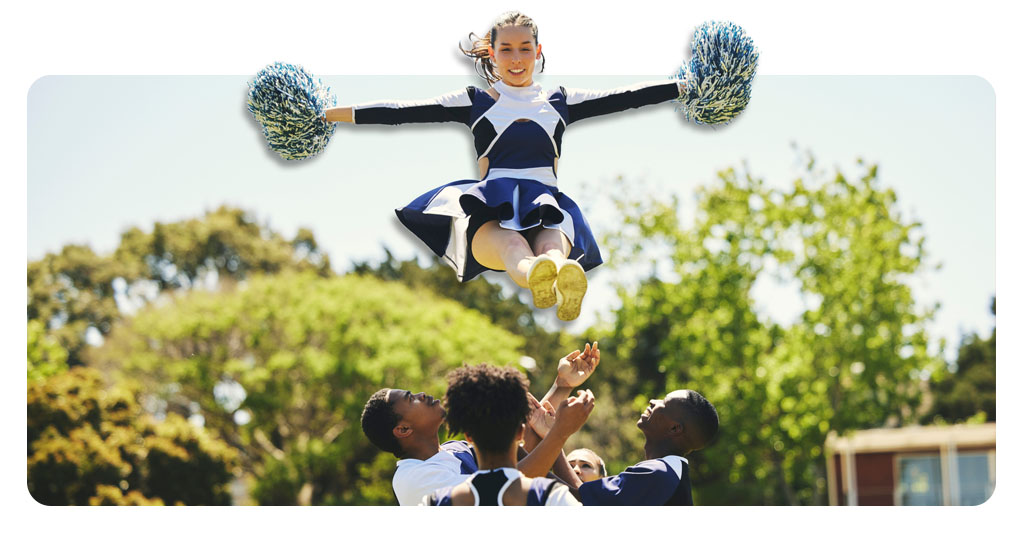Cheerleading has grown far beyond sideline chants and pom-poms. For many children, it’s a way to express energy and build lasting self-confidence through teamwork and physical movement. As a parent, you may have questions about safety and how to choose the right team.
This Insiderbits guide was created to help families make informed decisions about cheerleading. From understanding the best age to begin, to selecting gyms and supporting your child through training, you’ll find everything you need to start strong, on and off the mat.
- 3 Best Workout Apps for High-Intensity Training
- A Free Home Workout App for Everyone
- Abdominal Workout App: Build Abs in 30 Days
Cheerleading for Beginners: How to Get Your Kid Involved
The first step to getting your child into cheerleading is to explore local options. This could include school teams, community centers, or private cheer gyms with beginner classes.
Start by researching programs in your area that accept new athletes with no prior experience. Many organizations offer rec cheer or non-competitive classes that focus on fundamentals like jumps, stunts, and chants.
If your child is younger, look for programs designed for ages 5 to 7, which usually focus more on coordination and socialization than complex choreography.
In contrast, older children may benefit from structured tryout-based teams, which often provide more frequent training and access to local or national competitions.
Make sure to visit the gym or center beforehand. Observing a class gives you a feel for the environment and whether it matches your child’s energy and comfort level.
Ask about schedules, coaching credentials, and the gear needed for first-timers. Some programs provide uniforms and pom-poms; others may require personal purchases.
Cheerleading is inclusive and adaptable. Many programs welcome all genders and offer flexible entry points regardless of physical shape or athletic background.

Benefits of Cheerleading Beyond School Spirit
Cheerleading for beginners offers much more than spirited chants and halftime performances. It builds a foundation of life skills that can follow children well beyond the mat or gym.
One of the biggest benefits is physical development. Cheer helps improve flexibility, balance, strength, and cardiovascular health through repetitive movement and active routines.
It also teaches teamwork and cooperation, as every stunt and formation depends on trust, timing, and mutual support between teammates. Confidence naturally grows as children perform in front of others.
Socially, cheerleading provides a close-knit environment where kids form friendships, learn to encourage others, and develop respect for leadership and group discipline.
These benefits apply to both competitive and recreational cheer programs, making the sport a valuable tool for overall youth development.
Finding the Right Team or Gym to Start With
Choosing the right cheerleading for beginners environment is one of the most important steps for a positive experience, especially for beginners. The right fit helps your child feel welcome and stay motivated.
Start by looking for gyms or teams that offer introductory or recreational cheer programs. These classes usually have fewer training hours and focus on basics instead of competition pressure.
Ask if the coaches are certified through organizations like USA Cheer or have experience working with children in developmental stages.
Visit the facility before enrolling. A clean, organized space with proper mats, crash pads, and attentive staff is a strong indicator of a safe and structured training environment.
It’s also helpful to watch a class in action. Observe how the coaches interact with kids, how instructions are given, and how the team responds to mistakes or corrections.
Some gyms specialize in competitive squads, while others focus on fun and fitness. Make sure the program’s goals match your child’s interests.
Don’t hesitate to ask about costs. Some programs include everything in the enrollment fee, others may require uniforms, shoes, or travel expenses later on.
How to Support Your Child Through Training and Events
Parental support plays a huge role in a child’s cheerleading for beginners journey, especially during the early stages when routines, teamwork, and confidence are still developing.
Start by maintaining a consistent schedule and making sure your child arrives prepared. This includes eating well and bringing the right gear to every practice.
Always keep your child encouraged to talk about their experience. Ask what they learned, what they enjoyed, and where they might need help, without pressuring for perfection. Don’t forget to celebrate progress.
Despite all the fun, cheerleading events can be long and intense. Show your presence at competitions or showcases, even if your child is not performing in a lead role; just being there matters.
Lastly, avoid comparing your child to others. Every athlete develops at their own pace, and positive reinforcement fosters a healthier and more enjoyable experience.
Key Safety Tips and Physical Readiness
Cheerleading for beginners is safe when approached with the right preparation. A simple medical check-up before starting helps confirm your child is physically ready for training.
Beginner routines still require stretching and warm-ups to prevent injuries, even when stunts are light. Teaching proper form early reduces long-term risks.
Consequently, parents need to look for programs with certified coaches who follow safety guidelines and know how to progress skills at the right pace for each age group.
When it comes to gear, cheer shoes are important for grip and support, avoid using regular sneakers during practice.
Make rest and hydration part of your child’s routine. Encourage them to speak up if they feel pain or discomfort during training.
Cheerleading for Beginners: What Parents Should Know – Conclusion
Starting your child in cheerleading is opening the door to a sport that blends athletic development and personal growth. With the right support, cheer becomes a space for your child to stay active and to build confidence.
Alongside, staying involved, and celebrating small wins can make a lasting impact on your child’s motivation and joy.
As you begin this journey, remember: it’s not about perfect routines or trophies, it’s about helping your child feel strong, supported, and excited to learn.
With patience and the right information, cheerleading can be a truly rewarding adventure.
Related: Student Incentives in the U.S.: Grants and Programs for Kids
Enjoyed this article? Save the Insiderbits blog to your favorites for the latest tools, creative tech tips, and photo editing breakthroughs.





